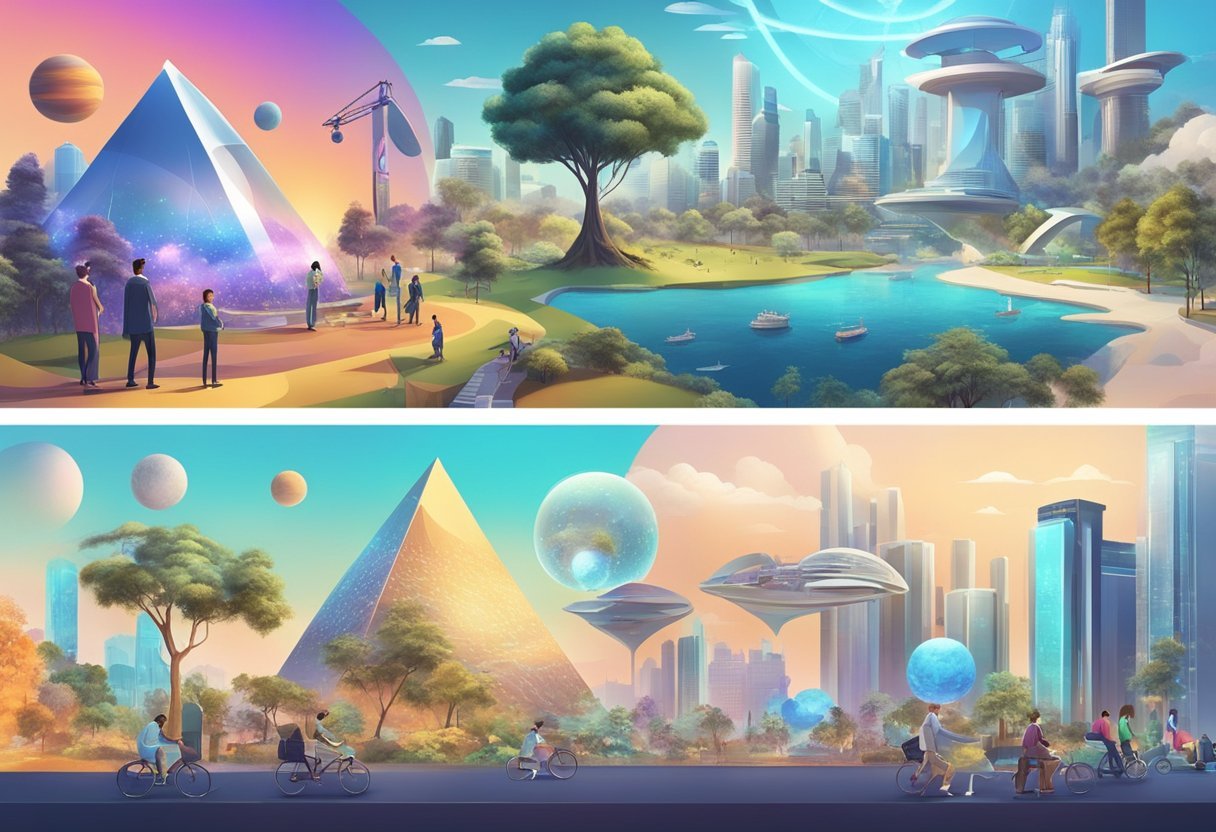The concept of the metaverse has been around for decades, but it has recently gained more attention due to the advancements in virtual reality technology. The metaverse can be described as a virtual world that is persistent and continues to exist even when users log off. It is a fully immersive experience where users can socialize, play, shop, and work.
The term “metaverse” was first introduced in Neal Stephenson’s 1992 science fiction novel Snow Crash. In the book, the metaverse is a virtual reality shared by millions of people, where they can interact with each other and with digital objects in a fully immersive environment. Since then, the concept of the metaverse has been explored in various forms of media, including movies, TV shows, and video games.
The history of the metaverse can be traced back to the early days of the internet, when virtual communities like Second Life and The Sims Online were created. These early virtual worlds allowed users to create avatars and interact with each other in a 3D environment. Over time, the technology behind these virtual worlds has advanced, leading to the development of more immersive experiences like VR headsets and haptic feedback devices. As technology continues to evolve, the possibilities for the metaverse are endless.
Origins and Evolution of the Metaverse
Early Concepts
The concept of the metaverse can be traced back to as early as 1838 when scientist Sir Charles Wheatstone first proposed the concept of “binocular vision”. This concept involved combining two images, one for each eye, to create a single 3D image. This idea laid the foundation for the development of virtual reality (VR) and augmented reality (AR) technologies.
Science Fiction Influences
The term “metaverse” was first introduced by Neal Stephenson in his novel “Snow Crash”, published in 1992. In the novel, Stephenson described a vast virtual reality space where users could interact with each other and explore a digital universe. This seminal work served as a major influence for the development and popularization of the metaverse.
Development of VR and AR Technologies
The development of VR and AR technologies in the late 20th and early 21st centuries has played a crucial role in the evolution of the metaverse. The internet and the World Wide Web have also been instrumental in the development of the metaverse, providing the infrastructure and connectivity necessary for users to interact with each other in a virtual space.
One of the earliest examples of VR technology was the Sensorama, developed by Morton Heilig in the 1950s. The Sensorama was a mechanical device that allowed users to experience a virtual reality environment by stimulating their senses of sight, sound, touch, and smell.
In recent years, major tech companies such as Facebook, Google, and Microsoft have invested heavily in the development of VR and AR technologies, signaling a growing interest in the potential of the metaverse. As these technologies continue to evolve, it is likely that the metaverse will become an increasingly important aspect of our digital lives.
Technological Advancements
Rise of Virtual Worlds
The concept of virtual worlds dates back to the 1970s, but it was not until the late 1990s that it started gaining popularity. The virtual world Second Life, launched in 2003, allowed users to create their own avatars and interact with others in a fully immersive 3D environment. This marked the beginning of a new era of virtual reality (VR) technology.
The rise of virtual worlds paved the way for the development of the metaverse. In a virtual world, users can create their own avatars, interact with other users, and explore a vast digital landscape. The metaverse takes this concept to the next level, allowing users to interact with each other in a shared virtual space that spans multiple virtual worlds.
Growth of VR and AR Hardware
The growth of virtual reality (VR) and augmented reality (AR) hardware has played a significant role in the development of the metaverse. The first VR headset, the Oculus Rift, was released in 2016, and it quickly became a popular choice among gamers and tech enthusiasts. The HTC Vive, released the same year, also gained a following.
These headsets allowed users to experience VR in a more immersive way than ever before. In addition, the growth of AR technology, such as the Microsoft HoloLens, has made it possible to overlay digital information onto the real world. This has opened up new possibilities for the metaverse, allowing users to interact with virtual objects in a more natural way.
The growth of VR and AR hardware has made it possible for the metaverse to become a reality. As these technologies continue to evolve, we can expect to see even more exciting developments in the years to come.
Major Players and Platforms

The metaverse has seen a surge of interest in recent years, with many companies entering the fray in an attempt to carve out a piece of this emerging market. The following are some of the major players and platforms in the metaverse space.
Social Media Enters the Metaverse
Facebook, now known as Meta, has been one of the most prominent companies to enter the metaverse space. The company has been investing heavily in virtual and augmented reality technologies, and its rebranding to Meta is a clear indication of its ambitions in this area. Meta has already launched a beta version of its Horizon Workrooms platform, which allows users to collaborate in a virtual workspace.
Google has also shown interest in the metaverse, with its Daydream VR platform and Google Earth VR. However, the company has not yet made any significant moves in this area.
Gaming and Interactive Platforms
Roblox is a popular gaming platform that has also entered the metaverse space. The company has launched its own metaverse platform, which allows users to create and share their own virtual experiences. Fortnite, another popular gaming platform, has also made moves in the metaverse space, with its Party Royale mode.
Microsoft has been investing in the metaverse through its acquisition of AltspaceVR, a social VR platform. The company has also launched its own virtual workspace platform, Microsoft Mesh.
Minecraft, owned by Microsoft, has also been used as a platform for creating virtual experiences. Sony has also entered the metaverse space through its ownership of the popular game development company, Media Molecule.
Meta Platforms, formerly known as Facebook Reality Labs, is a subsidiary of Meta that focuses on developing VR and AR technologies. The company has been working on a range of products, including its Oculus VR headsets and the Horizon Workrooms platform.
The metaverse space has seen a surge of interest in recent years, with many companies entering the fray. While Facebook, now known as Meta, has been one of the most prominent companies to enter the space, many other companies, including Roblox, Fortnite, Microsoft, and Sony, have also made moves in this area.
Economic and Social Impact Of the Metaverse
The metaverse is an emerging technology that has the potential to revolutionize the way we live, work, and play. As such, it is expected to have a significant impact on both the economy and society as a whole. In this section, we will explore the various economic and social implications of the metaverse.
Commerce and Real Estate
One of the most significant impacts of the metaverse is expected to be on the world of commerce and real estate. With the advent of virtual reality, it will be possible to create fully immersive shopping experiences that allow consumers to interact with products in a way that was previously impossible.
This has the potential to revolutionize the way we shop, and it is expected to lead to significant growth in the e-commerce sector.
In addition to e-commerce, the metaverse is also expected to have a significant impact on the real estate industry. Virtual real estate is already a booming market, with some virtual properties selling for millions of dollars. As the metaverse continues to grow, it is likely that virtual real estate will become an increasingly important asset class.
Entertainment and Education
Another area where the metaverse is expected to have a significant impact is in the world of entertainment and education. Virtual reality has already been used to create immersive gaming experiences, and it is expected to play an increasingly important role in the entertainment industry in the years to come.
In addition to entertainment, the metaverse is also expected to revolutionize the way we learn. Virtual reality has the potential to create fully immersive educational experiences that allow students to interact with subjects in a way that was previously impossible.
This has the potential to make education more engaging and effective, and it is expected to lead to significant growth in the e-learning sector.
The metaverse is expected to have a significant impact on both the economy and society. It has the potential to revolutionize the way we live, work, and play, and it is likely to create new opportunities for investment, commerce, real estate, entertainment, and education. As such, it is an area that is worth watching closely in the years to come.

Future and Challenges
Interoperability and Open Standards
Interoperability is a major challenge for the metaverse. The metaverse is a complex ecosystem that requires a high degree of interoperability between different platforms and applications.
Open standards are essential for interoperability, but the current state of the metaverse is far from standardized. Different platforms and applications have their own proprietary standards, which makes it difficult for users to move between different platforms and applications.
To address this challenge, the metaverse needs to adopt open standards that allow for interoperability between different platforms and applications.
The adoption of blockchain technology and decentralized finance (DeFi) can help to standardize the metaverse and create a more open and interoperable ecosystem. This will enable users to move between different platforms and applications seamlessly, which will help to drive adoption and growth in the metaverse.
Privacy, Security, and Governance
Privacy, security, and governance are also major challenges for the metaverse. The metaverse is a highly decentralized and open ecosystem that requires robust privacy and security measures to protect users from malicious actors. The metaverse also requires effective governance to ensure that it operates in a fair and transparent manner.
To address these challenges, the metaverse needs to adopt robust privacy and security measures that protect users from malicious actors. This includes the adoption of encryption technologies and the use of decentralized identity protocols.
The metaverse also needs to adopt effective governance structures that ensure that it operates in a fair and transparent manner. This includes the adoption of decentralized governance models that allow users to participate in the decision-making process.
The future of the metaverse depends on its ability to address these challenges and create a more open, interoperable, and secure ecosystem.
The adoption of blockchain technology and decentralized finance can help to standardize the metaverse and create a more open and interoperable ecosystem, while the adoption of robust privacy and security measures and effective governance structures can help to protect users and ensure that the metaverse operates in a fair and transparent manner.

Frequently Asked Questions
What are the origins of the concept of the metaverse?
The concept of the metaverse originated in science fiction literature in the 1990s. The term was first coined by Neal Stephenson in his novel “Snow Crash” and referred to a virtual reality space where people could interact with each other and digital objects in a three-dimensional environment. The idea of the metaverse has since been adopted by technologists and futurists as a vision of the future of the internet.
Which companies are pioneering the development of the metaverse?
Many companies are currently investing in the development of the metaverse, but some of the most notable pioneers include Facebook (now Meta), Epic Games, Roblox, and Decentraland. These companies are creating virtual worlds and social platforms that allow users to interact with each other and digital objects in a three-dimensional environment.
How has the concept of the metaverse evolved over time?
The concept of the metaverse has evolved significantly since it was first introduced in science fiction literature. Originally, it was envisioned as a futuristic virtual reality space where people could interact with each other and digital objects. Today, the metaverse is seen as a new form of the internet that is more immersive and interactive than the traditional web.
What are some of the largest platforms currently shaping the metaverse?
Some of the largest platforms currently shaping the metaverse include Facebook Horizon, Roblox, and Second Life. These platforms allow users to create and explore virtual worlds, interact with each other and digital objects, and participate in a variety of activities such as gaming, socializing, and shopping.
In what ways has the metaverse influenced entertainment and media?
The metaverse has had a significant impact on entertainment and media by providing new ways for people to consume and interact with content.
For example, virtual concerts and events have become increasingly popular in the metaverse, allowing people to attend live performances from anywhere in the world. The metaverse has opened up new opportunities for creators to produce and distribute content in a more interactive and immersive way.
What technological advancements have been crucial to the development of the metaverse?
Several technological advancements have been crucial to the development of the metaverse, including virtual and augmented reality, blockchain, and cloud computing. These technologies have enabled the creation of immersive virtual worlds, decentralized ownership and governance, and scalable infrastructure to support large-scale user interactions.



